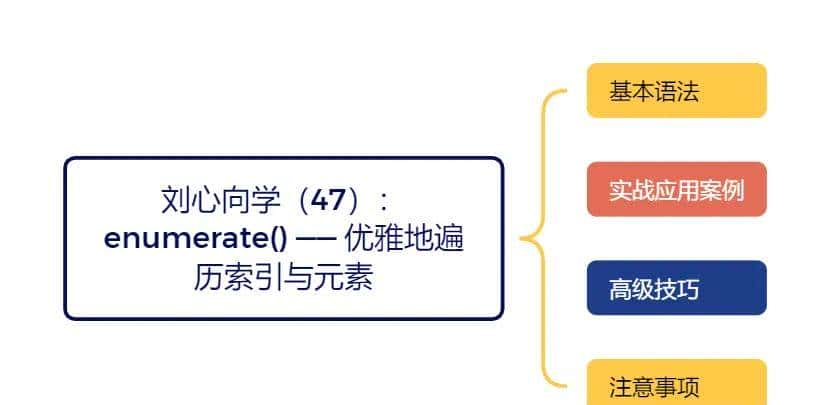
分享兴趣,传播快乐,
增长见闻,留下美好!
亲爱的您,这里是LearningYard新学苑。
今天小编为大家带来文章
“刘心向学(47):enumerate() —— 优雅地遍历索引与元素”
Share interest, spread happiness,
Increase knowledge, leave a beautiful!
Dear, this is LearningYard Academy.
Today, the editor brings you an article.
“Liu Xin Xiang Xue (47): enumerate() — Iterate with Index and Value, the Pythonic Way
Have you written code like this?”
Welcome to your visit.
一、思维导图(Mind Map)

二、引言(Introduction)
在编程中,我们常常需要“一边遍历,一边知道位置”。
传统方式:
In programming, we often need to “loop over items and know their position.”
The traditional way:
for i in range(len(data)):print(i, data[i])
问题:
Problems:
冗长
Verbose
易出错(如索引越界)
Error-prone (e.g., index out of bounds)
可读性差
Harder to read
而 enumerate() 的出现,正是为了解决这个问题:
enumerate() was designed to solve this:
for i, item in enumerate(items):
print (i, item)
简洁、清晰、安全。
Clean. Clear. Safe.
三、基本语法(Basic Syntax)enumerate (iterable, start=0)
iterable
:可迭代对象(列表、元组、字符串等)
iterable
: any iterable (list, tuple, string, etc.)start
:起始索引,默认为 0
start: starting index (default: 0)返回值
Return Value
返回一个 enumerate 对象,它是一个迭代器,生成 (index, value) 元组。
Returns an enumerate object — an iterator that yields (index, value) tuples.
items = ['a', 'b', 'c']
enum = enumerate(items)
print(list(enum)) # [(0, 'a'), (1, 'b'), (2, 'c')]解包使用(最常见)
Unpacking (Most Common)
for index, value in enumerate (items):
print(f"{index}: {value}")四、实战应用案例(Practical Use Cases)
1. 带序号的打印
Numbered Printing
fruits = ['apple', 'banana', 'cherry']
for i, fruit inenumerate(fruits, start=1):
print(f"{i}. {fruit}")
# 输出:
# 1. apple
# 2. banana
# 3. cherry2. 查找满足条件的索引
Find Indices by Condition
words = [“hello”, “world”, “python”]
for i, word inenumerate(words):
if"o"in word:
print(f"Found 'o' at index {i}: {word}")3. 构建元素到索引的映射
Build Value-to-Index Mapping
items = ['foo', 'bar', 'baz']
index_map = {item: i for i, item inenumerate(items)}
print(index_map) # {'foo': 0, 'bar': 1, 'baz': 2}4. 与列表推导式结合
With List Comprehensions
data = [10, 20, 30]
result = [f"{i}:{x}"for i, x inenumerate(data)]
print(result) # ['0:10', '1:20', '2:30']5. 避免多重 enumerate误区
Avoid Nested enumeratePitfalls
错误:嵌套 enumerate 不会自动对齐
Wrong: Nested enumerate doesn’t align automatically
a = [1, 2, 3]
b = ['x', 'y', 'z']
for i, x inenumerate(a):
for j, y inenumerate(b):
if i == j:
print(x, y) # 可读性差正确:使用 zip()for
Correct: Use zip()
x, y inzip(a, b):
print(x, y)
或带索引的 zip:
Or with index:
for i, (x, y) in enumerate(zip(a, b)):
print(i, x, y)五、高级技巧(Advanced Tips)
1. 自定义起始索引
Custom Start Index
for i, line in enumerate(log_lines, start=1):
print(f”[Line {i}] {line}”)
超级适合日志、文件行号等场景。
Perfect for logs, file lines, etc.
2. 与 zip()结合
Combined with zip()
names = ['Alice', 'Bob']
ages = [25, 30]
fori, (name, age) inenumerate(zip(names, ages), 1):
print(f”{i}. {name}is {age}years old”)
六、注意事项(Caveats)
1. enumerate是迭代器
enumerateis an Iterator
enum = enumerate(['a', 'b'])
print(list(enum)) # [(0, 'a'), (1, 'b')]
print(list(enum)) # [] —— 已耗尽!如需多次使用,转换为列表:
If you need to reuse it, convert to list:
enum_list = list(enumerate(items))
2. 何时不适用?(When Not to Use?)
仅需元素:直接 for item in items
Only need values: use for item in items
仅需索引:for i in range(n)
Only need indices: use for i in range(n)
需要复杂索引逻辑:仍可用 range(len())
Complex indexing logic: range(len()) may still apply
但 绝大多数“索引+元素”场景,enumerate() 都是首选。
But for most “index + value” cases, enumerate() is the best choice.
七、结语(Conclusion)
enumerate() 是 Python 中“小而美”的典范。
enumerate()
is a small but beautiful feature in Python.
它不复杂,却极大提升了代码的可读性与安全性。
It’s simple, yet greatly improves code readability and safety.
它提醒我们:
It reminds us:
“不要自己造轮子,善用内置工具。”
“Don’t reinvent the wheel — use built-in tools.”
从今天起,当你写下:
From now on, whenever you write:
for i in range(len(data)):
请停下来,问自己:
Pause and ask:
“我是不是该用 enumerate()?”
“Should I use enumerate() instead?”
大致率,答案是肯定的。
Chances are, the answer is yes.
由于真正的 Pythonic 代码,不是“能运行”,而是“清晰、简洁、优雅”。
Because truly Pythonic code isn’t just “working” — it’s clear, concise, and elegant.
而 enumerate(),正是通往这种境界的一小步。
And enumerate() is a small step toward that ideal.
今天的分享就到这里了。
如果您对文章有独特的想法,
欢迎给我们留言,
让我们相约明天。
祝您今天过得开心快乐!
That's all for today's sharing.
If you have a unique idea about the article,
please leave us a message,
and let us meet tomorrow.
I wish you a nice day!
参考资料:通义千问
参考文献:Beazley, D., & Jones, B. K. (2019). Python Cookbook (3rd ed.). O'Reilly Media.
Hettinger, R. (2019). Transforming Code into Beautiful, Idiomatic Python. PyCon US.
本文由LearningYard新学苑整理发出,如有侵权请在后台留言沟通!
LearningYard新学苑
文字:song
排版:song
审核|hzy



















暂无评论内容